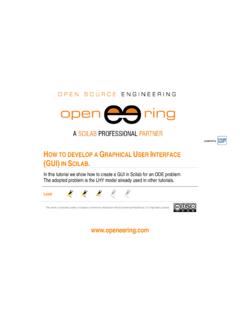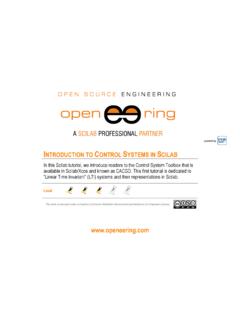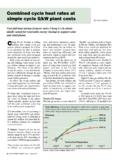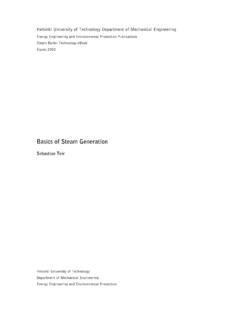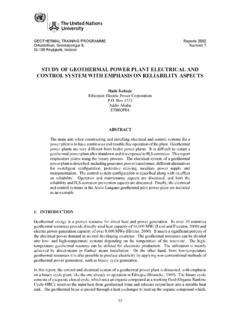Transcription of NUMERICAL SIMULATION OF AN ORGANIC …
1 Poweredby EnginSoft SpA - Via della Stazione, 27 - 38123 Mattarello di Trento | e IT00599320223 NUMERICAL SIMULATION OF AN ORGANIC rankine cycle Authors: S. Poles, M. Venturin Keywords: ORGANIC rankine cycle ; Scilab Abstract: The aim of this paper is to simulate an ORGANIC rankine cycle (ORC) using Scilab. The model is developed for estimating the operative conditions of the ORC system and its efficiency. Today, ORC technologies are widely used for simultaneous production of electrical and thermal energy ( cogeneration).
2 These systems can be a clean alternative to fossil fuels. Contacts This work is licensed under a Creative Commons Attribution-NonCommercial-NoDerivs Unported License. Organic_Rankine_Cycle page 2/14 1. Introduction In this article, we present a NUMERICAL solver for the SIMULATION of an ORGANIC rankine cycle (ORC) for the study of cogeneration, the simultaneous production of electrical and thermal energy. Today, ORC cycles are used as an alternative to the use of fossil fuels, that raise serious environmental concerns.
3 Exploiting ORC cycles, besides reducing the reliance on non-renewable and limited fossil fuels, can enhance environmental quality, reduce carbon emissions and be economically competitive. Moreover, cycles based on wood-burning cogeneration offer the advantage of clean elimination of wood wastes. The ideal process of an ORC system with its major components is depicted in Figure 1 along with the thermodynamics states of the working fluid. Figure 1: An ideal ORC cycle along with its thermodynamics states This system is composed by an evaporator, a condenser, a pump and a turbine.
4 From state 1 to 2, an ideal pump executes an adiabatic, reversible (isentropic) process to raise the working fluid from the pressure of saturated liquid to the pressure of saturated vapor. From state 2 to state 3, an evaporator heats the fluid at a constant pressure (isobar transformation) moving from a saturated liquid state 2 to a saturated vapor state 3 where all the liquid becomes vapor. Then the fluid is superheated until it reaches the state 3. After, the superheat vapor fluid enters in a turbine where it is produces an expansion through and adiabatic, reversible process.
5 The superheat process is necessary in order to guarantee that in the turbine only vapor is present, this preserving the turbine blades from condensation and erosion. However, the amount of superheat should be kept as lower as possible in order to avoid waste of energy and maximize the performance of the entire cycle . The typically used working fluid is an ORGANIC fluid which permits low-grade heat sources. It is characterized by low latent heat and high density. These properties are useful to increase the turbine inlet mass flow rate.
6 Common working fluids that can be used are hexamethyldisiloxane (MM) and octamethyltrisiloxane (MDM). In this work, we describe a NUMERICAL tool for the SIMULATION of steady state solutions of ORC systems. This toolbox has been completely written in Scilab and is available for download at the Openeering site. Organic_Rankine_Cycle page 3/14 2. The ORC system The considered ORC system is represented in Figure 2. Figure 3 depicts the thermodynamics states of the working fluid, and of the diathermic oil and the water used to heat up and cool down the working fluid.
7 Figure 2: ORC cycle Figure 3: Thermodynamics states Organic_Rankine_Cycle page 4/14 The system described in Figure 2 is a bit more complex than the one in Figure 1. Indeed, this last system differs from the previous scheme by the introduction of a regenerator. The regenerator transfers energy from the fluid at hot temperature to the fluid at low temperature. This step increases the efficiency of the entire cycle because the external heat transfer now occurs at a higher average temperature.
8 The working fluid In our SIMULATION we used the ORGANIC MDM fluid with the following properties [1,2,3]: Table 1: MDM properties Molecular formula C8H24O2Si3 Molecular weight g/mol Density g/cm3 Melting point -82 C Boiling point 153 C Refractive index Flash point 29 C Vapor pressure 50 mmHg (at 72 C) Specific heat of vaporization kJ/g Specific heat of combustion kJ/g Acentric factor Critical temperature C Critical pressure 1420 kPa In the ORC cycle the fluid changes its state from liquid to vapor and vice-versa.
9 Hence, it is necessary to monitor this condition by means of an equation of state. Here, in our model we choose the Peng-Robinson equation of state, which identifies the state of the fluid giving a relation from the saturation temperature and pressure [4]. From Figure 4 to Figure 11 we report the properties of the MDM working fluid. Organic_Rankine_Cycle page 5/14 Figure 4: MDM specific heat Figure 5: MDM density Figure 6: MDM conductivity Figure 7: MDM viscosity Figure 8: MDM enthalpy Figure 9: MDM entropy Organic_Rankine_Cycle page 6/14 Figure 10: MDM T-H diagram.
10 Figure 11: MDM T-s diagram. Heat exchangers modeling for evaporator, regenerator and condenser Modeling heat exchangers means providing the models that describe the heat transfer from hot to cold fluids. All the considered heat exchangers are of countercurrent flow type. A basic scheme of a generic heat exchanger is presented in Figure 12 where: T hot in is inlet temperature of the hot fluid; T hot out is outlet temperature of the hot fluid; T cold in is inlet temperature of the cold fluid; T cold out is outlet temperature of the cold fluid.



